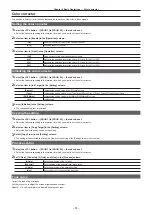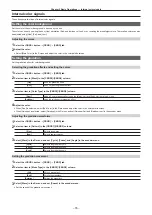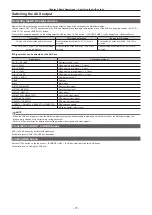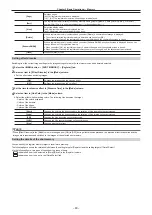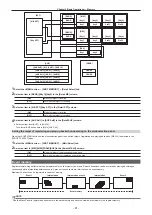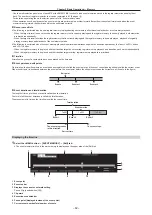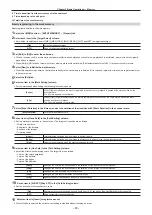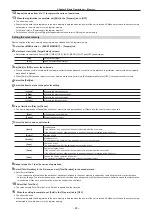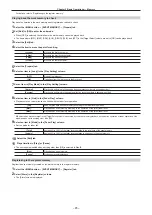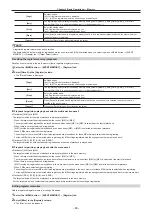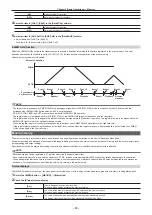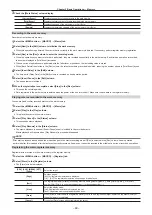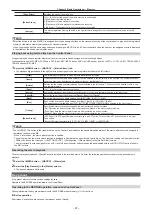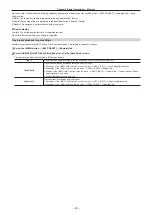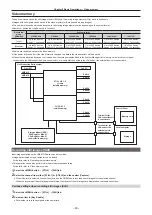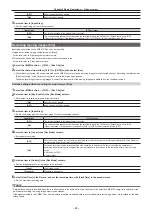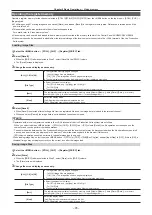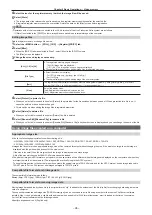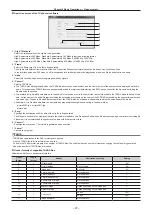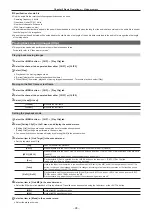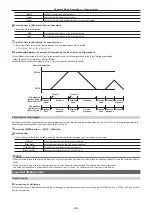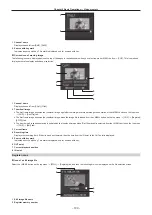
– 86 –
Chapter 5 Basic Operations — Memory
[Page]
Switches pages.
[ALL]: All registered memories are displayed.
[1-X] - [9-X]: The registered memories on each page are displayed.
[Sort]
The registered memory display is sorted by memory name ([Name
+
]/[Name
−
]), date ([Date
+
]/[Date
−
]), or memory
number ([No
+
]/[No
−
]), in either ascending order (
+
) or descending order (
−
).
[View]
Select the display mode.
[List]: Registered memories are displayed in a list.
[Icon]: Registered memories are displayed as icons.
[Store]
When [Store] is selected while a registered memory that is to be a registration target is selected, the event memory of
the work memory is registered.
[Cancel]
Closes the [Store] screen without registering the target.
@
@
NOTE
t
A registered register memory can be overwritten.
t
The items selected as the targets for registration are the ones for which [ON] is selected when you select top menu <MEM> button
→
[EVENT
MEMORY]
→
[Prepare] tab
→
[Target Select] column.
Recalling the register memory (playback)
Recall an event memory to the work memory from a registered register memory.
1
Select the <MEM> button
→
[EVENT MEMORY]
→
[Register] tab.
2
Select [Recall] in the [Register] column.
f
The [Recall] screen is displayed.
[Page]
Switches pages.
[ALL]: All registered memories are displayed.
[1-X] - [9-X]: The registered memories on each page are displayed.
[Sort]
The registered memory display is sorted by memory name ([Name
+
]/[Name
−
]), date ([Date
+
]/[Date
−
]), or memory
number ([No
+
]/[No
−
]), in either ascending order (
+
) or descending order (
−
).
[View]
Select the display mode.
[List]: Registered memories are displayed in a list.
[Icon]: Registered memories are displayed as icons.
[Recall]
When [Recall] is selected while a registered memory that is to be a recall source is selected, the event memory is
recalled to the work memory.
[Cancel]
Closes the [Recall] screen without recalling the target.
r
Playback target (when playing back with the multi-selection panel)
f
Playback of [ME1] and [ME2]
The target selected at the start of playback is always played back.
- When the target selected at registration is either one of [ME1] or [ME2]
The target selected at registration is played back even when either [ME1] or [ME2] is selected at the start of playback.
- When there is no target selected at registration
[ME1] recorded at registration is played back even when either [ME1] or [ME2] is selected at the start of playback.
- When 2 MEs were selected when registering
The settings for the relevant ME when it was registered are played back for those MEs that were selected when registering.
For those MEs that were not selected when registering, the ME settings registered with the youngest numbers are played back.
f
Playback of [DSK], [CLIP], [AUX], and [CBGD]
The target selected by both operations at registration and the start of playback is played back.
r
Playback target (when playing back with the menu panel)
f
Playback of [ME1] and [ME2]
The target selected at the start of playback is always played back in the work memory.
- When the target selected at registration is either one of [ME1] or [ME2]
The target selected at registration is played back in the work memory even when either [ME1] or [ME2] is selected at the start of playback.
- When there is no target selected at registration
[ME1] recorded at registration is played back in the work memory even when either [ME1] or [ME2] is selected at the start of playback.
- When 2 MEs were selected when registering
The settings for the relevant ME when it was registered are played back in the work memory for those MEs that were selected when registering.
For those MEs that were not selected when registering, the ME settings registered with the youngest numbers are played back in the work memory.
f
Playback of [DSK], [CLIP], [AUX], and [CBGD]
The target selected at the start of playback is always played back in the work memory.
For the target which is not selected at registration, playback is performed with the setting at registration.
Editing register memories
Delete a registered register memory or change file names.
1
Select the <MEM> button
→
[EVENT MEMORY]
→
[Register] tab.
2
Select [Misc] in the [Register] column.
f
The [Misc] screen is displayed.
Summary of Contents for Live Production Suite Series
Page 5: ...Please read this chapter and check the accessories before use Chapter 1 Overview ...
Page 11: ...This chapter describes installation and connection Chapter 2 Installation and Connection ...
Page 50: ...This chapter describes menu operations Chapter 5 Basic Operations ...
Page 113: ...This chapter describes the configuration of operations Chapter 7 Configuring Operations ...
Page 122: ...This chapter describes how to operate system menus Chapter 8 System Menu ...
Page 136: ...This chapter describes plug in functions Chapter 9 External Interfaces ...
Page 140: ... 140 Chapter 10 Specifications Dimensions Dimensions of the XPT Unit AV LSX10 Unit mm inch ...
Page 141: ... 141 Chapter 10 Specifications Dimensions Dimensions of the ME Unit AV LSM10 Unit mm inch ...
Page 153: ...This chapter describes the setting menu table and terms Chapter 11 Appendix ...
Page 176: ...Web Site https www panasonic com Panasonic Corporation 2020 ...



